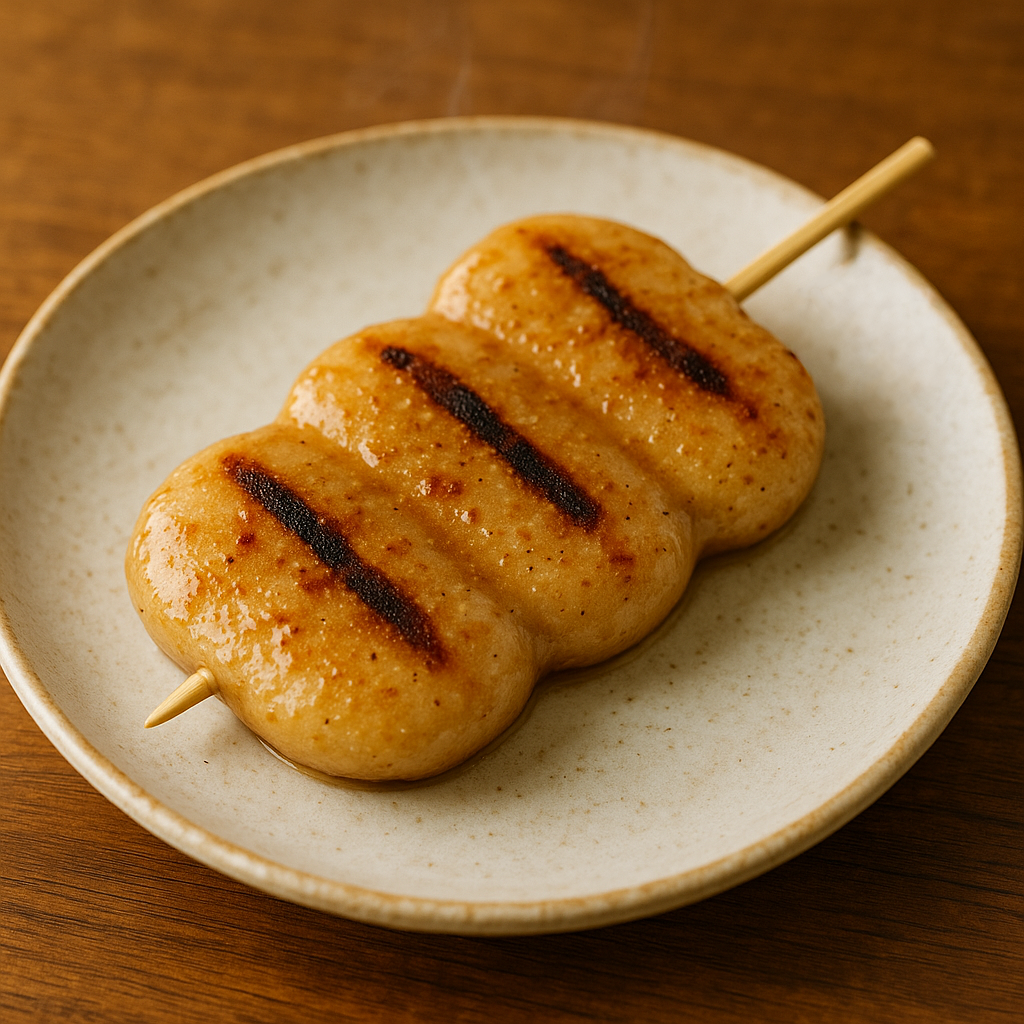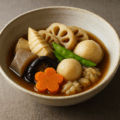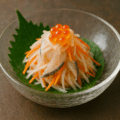お茶もち(岩手)の特徴
うるち米粉の団子を焼き上げ、くるみだれで香ばしく
お茶もちは、うるち米の粉で作った団子を2〜3個串に刺して薄くつぶし、焼き目をつけてから、くるみだれ(しょうゆ味またはみそ味)で仕上げる郷土のおやつです。焦げ目の香りと、木の実のコク、甘じょっぱい味わいが楽しめます。
「うちわ餅」とも呼ばれる扇形の成形
団子を扇(うちわ)のように広げて焼くことから「うちわ餅」とも呼ばれます。囲炉裏や網であぶって食べられてきた歴史があり、来客時の“お茶っこ”、農家の小昼や子どものおやつとして親しまれてきました。
お茶もち(岩手) レシピ
材料(5人分)
- 上新粉(うるち米粉) 200g
- 熱湯 180〜220ml(加減用)
- くるみ 80g(軽く炒って皮除去)
- 砂糖 30〜50g
- しょうゆ 小さじ2〜3
- みりん 大さじ1〜2
- 水 大さじ3〜5(たれののばし用)
- 油 少量(焼き用)
- 竹串 5〜6本
作り方
- くるみだれを作る:くるみをすり鉢で細かくすり、砂糖・しょうゆ・みりん・水でのばす。
- 生地:上新粉に熱湯を少しずつ加え、木べらで練り、手でまとめ、耳たぶ程度にこねる。
- 成形:2〜3個ずつ丸めて串に刺し、扇形に薄くつぶす。
- 焼く:フライパン(薄く油)または網で中火。両面に焼き色がつくまで焼く。
- 仕上げ:熱いうちにくるみだれを塗り、再度焼いて完成。
シェフのワンポイントアドバイス
- 加水は少しずつがコツです。柔らかすぎたら上新粉、固ければ熱湯で微調整します。
- たれは餅に絡むとろみが大切です。水分で濃度を調整すると、むらなく塗れます。
- 香ばしさ重視なら一度塗り→軽くあぶって二度塗りすると風味が立ちます。
栄養価(1人分の目安)
- エネルギー:250〜360 kcal
- たんぱく質:4〜7 g
- 脂質:7〜14 g(くるみ量で変動)
- 炭水化物:40〜55 g
- 食物繊維・ミネラル:くるみ由来
歴史
扇形の成形に由来する呼び名
団子を扇(軍配うちわ)の形に広げる見た目から「うちわ餅」と呼ばれるようになったと伝えられます。串に刺して薄くつぶし、あぶってから食べる所作も特徴的です。
“お茶っこ”と小昼に根づく郷土の味
米粉文化が育った地域で、来客時の“お茶っこ”や農家の小昼、子どものおやつとして受け継がれてきました。くるみだれはしょうゆ味・みそ味の両系統があり、家ごとの配合が今も伝わっています。
English Version
Features of Ocha Mochi (Iwate)
Toasted rice-flour dumplings with walnut sauce
Ocha mochi is a local sweet made by skewering 2–3 rice-flour dumplings, flattening them, toasting until lightly browned, and finishing with a walnut sauce (soy-based). The charred aroma, nutty richness, and sweet-salty taste make it a favorite.
Also called “Uchiwa Mochi” for its fan shape
The dumplings are pressed into a fan shape and toasted over a pan or grate. It has roots in irori hearth cooking and has long been served for “ochakko” tea breaks, farmers’ small midday snacks, and children’s treats.
Ocha Mochi (Iwate) – Recipe
Ingredients (Serves 5)
- Joshinko (non-glutinous rice flour) 200 g
- Boiling water 180–220 ml (as needed)
- Walnuts 80 g (lightly toasted, skins removed)
- Sugar 30–50 g
- Soy sauce 2–3 tsp
- Mirin 1–2 Tbsp
- Water 3–5 Tbsp (to thin the sauce)
- Oil, a little (for pan)
- Bamboo skewers 5–6
Directions
- Walnut sauce: Grind walnuts finely; add sugar, soy sauce, mirin, and water to a brushable consistency.
- Dough: Add boiling water gradually to joshinko; stir, then knead until soft and pliable.
- Shape: Roll into small balls (2–3 per skewer), thread onto skewers, and press into a fan shape.
- Toast: Pan (lightly oiled) or grate over medium heat until lightly browned on both sides.
- Finish: Brush with walnut sauce while hot; optionally re-toast briefly and brush again.
Chef’s Tips
- Add hot water little by little; adjust with flour or water for texture.
- Sauce should lightly cling to the surface; fine-tune thickness with water.
- For deeper aroma, brush once, toast lightly, then brush a second time.
Nutrition (per serving, approx.)
- Energy: 250–360 kcal
- Protein: 4–7 g
- Fat: 7–14 g (varies with walnut amount)
- Carbohydrates: 40–55 g
- Fiber & minerals: mainly from walnuts
History
Name derived from the fan-shaped form
Flattening the skewered dumplings into a “uchiwa” (hand fan) shape and toasting them led to the name “Uchiwa Mochi.” The skewer-press-toast sequence is characteristic of the dish.
Rooted in “ochakko” tea breaks and farm snacks
In rice-flour regions of Iwate, it became a staple for welcoming guests with tea, for farmers’ small midday breaks, and as a children’s treat. Soy-based walnut sauce is standard, with household variations preserved today.



何でも質問してください!